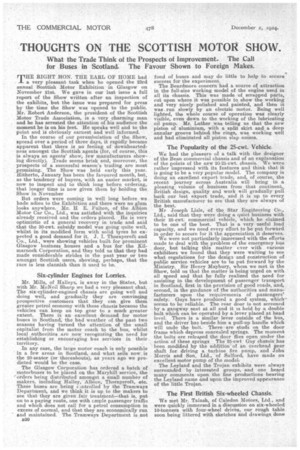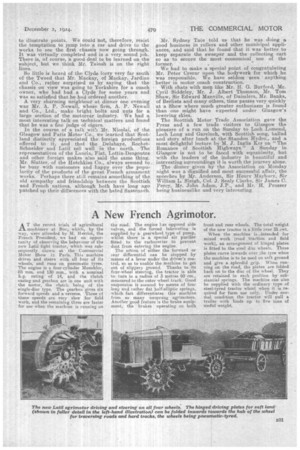THOUGHTS ON THE SCOTTISH MOT011 SHOW.
Page 14

Page 15

If you've noticed an error in this article please click here to report it so we can fix it.
What the Trade Think of the Prospects of ImprovementThe Call for Buses in Scotland. The Favour Shown to Foreign Makes.
FTHE RIGHT HON. THE EARL OF HOME had -Ia very pleasant task when he opened the 23rd annual Scottish Motor Exhibition in Glasgow on November '21st. We gave in our last issue a full report of the Show written after an inspection of the exhibits, but the issue was prepared for press by the time the Show was opened to the public. Mr. Robert Anderson, the president of the Scottish Motor Trade Association, is a very charming man and he has arrested the attention of his audience the moment he is on his feet. He speaks well and to the point and is obviously earnest and well informed.
In the course of our perambulation of the Show, spread over a period of three days, it rapidly became apparent that there is no feeling of downheartedness amongst the Scottish agents (for, of course, this is .always an agents' show, few manufacturers showing directly). Trade seems brisk and, moreover, the prospects of a successful season's trading are most promising. The Show was held early this year. Hitherto, January has been the favoured month, but, as the tendency of buyers, with an easier market, is now to inspect and to think long before ordering, that longer time is now given them by holding the Show in November
But orders were coming in well long before we bade adieu to the Exhibition and there were no glum looks anywhere. Mr. H E. Fulton, of the Albion Motor Car Co., Ltd., was satisfied with the inquiries already received and the orders placed. He is very optimistic of a general recovery in trade and said that the 30-cwt. subsidy model was going quite well, whilst in its modified form with solid tyres he expected a good demand for it, J. I. Thornyeroft and Co., Ltd., were showing vehicles built for prominent Glasgow business houses and a bus for the Kilmarnock Corporation, and they told us that they had made considerable strides in the past year or two amongst Scottish users, showing, perhaps, that the race is less clannish than it used to be,
Six-cylinder Engines for Lorries.
Mr. Mills, of Halleys, is away in the States, but with Mr. McNeil Sharp we had a very pleasant chat. The six-cylinder-engined chassis are going well and doing well, and gradually they are convineang prospective customers that they can give them greater petrol economy with these chassis because the vehicles can keep on top gear to a much greater extent. There is an excellent demand for motor buses in Scotland, the bad weather of the past two seasons having turned the attention of the small capitalist from the motor coach to the bus, whilst local authorities are now recognizing the need for establishing or encouraging bus services in their territory.
In any ease, the large motor coach is only possible in a few areas in Scotland, and what sells now is the 20-seater (br thereabouts), as years ago we predicted would be the case.
The Glasgow Corporation has ordered a batch of Motorbuses to be placed on the Maryhill service, the orders being distributed amongst a small number of makers, including Halley, Albion, Thornycroft, etc. TheSe buses are being ntrolled by the Tramways Department, and we think it is up to the makers to see that they are given fair treatment—that is, put on to a paying route, one with smple passenger traffic and which does not call for a petrol consumption in excess of normal, and that they are economically run and maintained. The Tramways Department is not 1330 fond of buses and may do little to help to secure success for the experiment. The Beardmore concern had a source of attraction in the full-size working model of the engine used in all its chassis.. This was made of scrapped parts, cut open where it was possible to show the working and very nicely polished and painted, and then it was run slowly by an electric motor. Being well lighted, the whole course of operation was clearly visible, even down to the working of the lubricating oil pump. Mr. Luther was telling us that the new piston of aluminium, with a split skirt and a deep annular groove behind the rings, was working well and had eliminated all piston slap noises.
The Popularity of the 25-cwt. Vehicle.
We had the pleasure of a talk with the designer of the Bean commercial chassis and of an explanation of the points of the new 20-25-cwt. chassis. We were rather impressed with its features and think that it is going to be a very popular model. The company is doing an excellent export trade, and, of course, the .recent journey across Australia will bring in a pleasing volume of business from that continent, British design, quality and work will gradually pull back our lost export trade, and it is up to every British manufacturer to see that they are always of the best.
Mr Joseph Lisle, of the Star Engineering Co., Ltd., said that they were doing a quiet business with their 25-cwt. commercial vehicle, which he claimed to be one of the best. That is a very useful load capacity, and we need every effort to be put forward in order to secure for it the appreciation it deserves.
We were not particularly impressed with the efforts made to deal with the problem of the emergency Inas door, but talking this matter ever with various exhibitors we found that they were waiting to see what regulations for the design and construction of public service vehicles are to be put forward by the Ministry. Sir Henry Maybury, whom we met in the Show, told us that the matter is being urged on with all speed and that he fully realized the need for assisting in the development of passenger transport in Scotland, first in the provision of good roads, and, second, in the guidance of the authorities and manufacturers upon the requirements of passengers' safety. Guys have produced a good system, which seems to he reliable. The rear door is not screened by a gangway seat at all and A is held by a double bolt which can be operated by a lever placed at head level. There is a similar lever outside of the bus, and the driver has beside him a pull-up handle which will undo the bolt. There . are studs on the door frame which depress concealed springs. The moment the bolts are reIeaped the door flies open under the action of these springs The 25-cwt Guy ehatsis has been modified by the additionof an overhead gear shaft for driving a turbine fire pump, and John Morris and Son, Ltd.' of Salford, have made an excellent motor pump of the model.
The Leyland and the Trojan exhibits were always surrounded by interested groups, and one heard many comments upon the fine productions bearing the Leyland name and upon the improved appearance of the little Trojan.
The First British Six-wheeled Chassis.
We met Mr. Tainsh, of Caledon Motors, Ltd., and were quickly immersed in a discussion on six-wheeled 10-tonners with four-wheel drives, our rough table soon being littered with sketches and drawings done
to illustrate points. We could 'not, therefore, resist the temptation to jump into a car and drive to the works to see the first chassis now going through. It was virtually completed and is a very sound job. There is, of course, a good deal to be learned on the subject, but we think Mr. Tainsh is on the right lines.
So little is heard of the Clyde lorry very far south of the Tweed that Mr. Mackay, of Mackay, Jardine and Co., rather surprised us by saying that the chassis on view was going to Yorkshire for a coach owner, who had had a Clyde for some years and was so satisfied that he•had ordered another.
A very charming neighbour at dinner one evening was Mr. A. P. Nowa11, whose firm, A. P. Newa,11 and Co., Ltd., make bright bolts and nuts for a large section of the motorcar industry. We had a most interesting talk on technical raatters and found that he was a fine judge of cigars.
In the course of a talk wit'a Mr. Nicolai, of the Glasgow and Paris Motor Co., we learned that Scotland distinctly appreciated the foreign productions offered to it, and that the Delahaye, RochetSchneider .and Lath sell well in the north. The representatives of the Lancia, Fiat, Lottin-Desgoutes and other foreign makes also said the same thing. Mr. Slatter, of the Hotchkiss Co., always seemed to be .busy with eustomers and happy over the popularity of the products of the great French armament works. Perhaps there still remains something of the old sympathy and friendship between the Scottish and French nations, although both have long ago patched up their diffarences with the hated Sassenach. Mr. Sydney Tate told us that he was doing a good business in rollers and other municipal appliances, and said that he found that it was better to keep separate the sweeper and the collecting cart so as to secure the most economical use of the
former. • We had to make a special point of congratulating Mr. Peter Crerar upon the bodywork for which he was responsible. We have seldom seen anything better in motor coach construction.
With chats with men like Mr. II. G. Burford, Mr. Cyril Siddeley, Mr. J. Albert Thomson, Mr. Tom Shaw, Sir Edward Manville, of Daimlers, Mr. Banks, of Berliets and many others, time passes very quickly at a Show where much greater enthusiasm is found than one might have espeoted under Glasgow's lowering skies. The Scottish Motor Trade Association gave the Press and a few trade visitors to Glasgow the pleasure of a run on the Sunday to Loch Lomond, Loch Long and Gareloch, with Scottish song, ballad and story after lunch at the Standon Hydro:, and a most delightful lecture by M. J. Inglis Ker on " The Romance of Scottish Highways." A Sunday in Glasgow is not to be faced with equanimity, but with the leaders of the industry in beautiful and interesting surroundings it is worth the journey alone. The dinner given by the Association on Monday night was a dignified and most successful affair, the speeches by Mr. Anderson, Sir Henry. Mayhury, Sir William L. Sleigh, Col. J. Sealy Clarke, Sir James C. Percy, Mr. John Adam, J.P., and Mr. H. Prosser being businesslike and very interesting
































